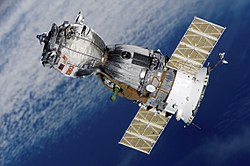| COSPAR ID | 1990-107A |
|---|---|
| SATCAT no. | 20981 |
| Mission duration | 175 days, 1 hour, 50 minutes, 41 seconds |
| Orbits completed | ~2,735 |
| Spacecraft properties | |
| Spacecraft | Soyuz 7K-STM No. 61 |
| Spacecraft type | Soyuz-TM |
| Manufacturer | NPO Energia |
| Launch mass | 7,150 kilograms (15,760 lb) |
| Crew | |
| Crew size | 3 |
| Members | Viktor Afanasyev Musa Manarov |
| Launching | Toyohiro Akiyama |
| Landing | Helen Sharman |
| Callsign | Дербе́нт (Derbent) |
| Start of mission | |
| Launch date | 2 December 1990, 08:13:32 UTC |
| Rocket | Soyuz-U2 |
| End of mission | |
| Landing date | 26 May 1991, 10:04:13 UTC |
| Landing site | near Dzhezkazgan |
| Orbital parameters | |
| Reference system | Geocentric |
| Regime | Low Earth |
| Perigee altitude | 367 kilometres (228 mi) |
| Apogee altitude | 400 kilometres (250 mi) |
| Inclination | 51.6 degrees |
| Period | 92.2 minutes |
| Docking with Mir | |
| Docking date | 4 December 1990, 09:57:09 UTC |
| Undocking date | 26 May 1991, 06:15:59 UTC |
 Soyuz programme (Crewed missions) | |
Soyuz TM-11 was the eleventh expedition to the Russian space station Mir, using a Soyuz-TM crew transport vessel. The mission notably carried a Japanese television reporter from Tokyo Broadcasting System. [1]

